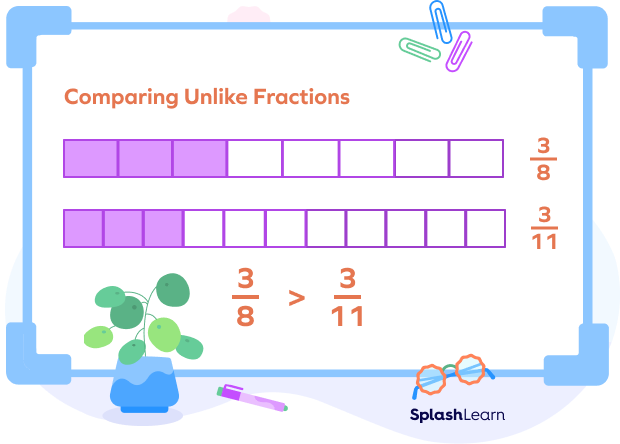What Are Like and Unlike Fractions?
If two or more fractions have the same denominator, they are called “like fractions.” For example,
If two or more fractions have different denominators, they are called “unlike fractions.” For example,
Recommended Games
What Is a Fraction?
A fraction represents parts of a whole. A fraction has two parts. The number on the top of the line is called the numerator. It tells how many equal parts of the whole are taken. The number below the line is called the denominator. It shows the total number of equal parts the whole is divided into or the total number of the same objects in a collection.
Example 1: If a cake is divided into eight equal pieces, then each slice is “one-eighth” or “1 by 8” or

Example 2: There are a total of 5 children. 3 out of 5 are girls. So, the fraction of girls is 35.
Recommended Worksheets
What Are Like Fractions?
Like Fractions Definition: Like Fractions are the fractions that have the same denominator. Like fractions are fractions whose denominators are equal.
In other words, in the like fractions, the number of equal parts the whole is divided into remains the same, which is represented by the common denominators.
Like Fractions Examples: In
What Are Unlike Fractions?
Unlike Fractions Definition: Unlike Fractions are the fractions which have different denominators. Their denominators are not equal.
So, how do you identify unlike fractions? Simply check their denominators!
Unlike Fractions Examples: In

Comparing Like and Unlike Fractions
We can compare the fractions using different ways. To compare like fractions, simply compare their numerators.
Example: Let us compare like fractions
To compare like fractions, simply compare their numerators.
Thus,
Here’s another way.
To represent
To represent
The shaded region for
Thus,

Comparing like fractions is easy as we just have to compare their numerators, but for comparing unlike fractions, we have to convert unlike fractions to like fractions.
While comparing two or more unlike fractions, there are two different cases.
- Unlike Fractions with Same Numerators
In this case, the fraction with the greater denominator is the smallest and the fraction with a smaller denominator is the largest.
Suppose we have to compare
Numerators are the same.
Thus,
Since 3 shaded parts of 8 are bigger than the 3 shaded parts of 11, we can say that

- Unlike Fractions with Different Numerators
In this case, we can use two methods:
To cross multiply fractions, we multiply the numerator of the first fraction with the denominator of the second fraction and the numerator of the second fraction with the denominator of the first fraction. Finally compare the products to compare the fractions.
(Note that you can use this method to compare any two fractions, but it is convenient to use when comparing unlike fractions.)
Example:
Cross multiplying, we get
Thus,
2. Making Denominators Same (LCM method)
We first convert unlike fractions to like fractions by taking LCM of their denominators. Suppose we have to compare
Here,
So,
Addition of Like and Unlike Fractions
We can simply add two or more like fractions by adding the numerators and keeping the denominators the same.
Example:
For adding two unlike fractions, we first convert them to like fractions by finding the LCM of the denominators and then adding them.
Example:
LCM of 5 and 7 = 35
Subtraction of Like Fractions and Unlike Fractions
We can simply subtract two or more like fractions by subtracting the numerators and keeping the denominators the same.
Example:
For subtracting two unlike fractions, we first convert them to like fractions by finding the LCM of the denominators and then subtract them.
Example: Subtract
LCM of 5 and 7 = 35
Multiplication of Like and Unlike Fractions
For multiplying any two fractions (like or unlike fractions), we multiply the numerators separately and multiply the denominators separately, and then convert into the lowest term if needed.
Example 1:
Example 2:
Division of Like Fractions and Unlike Fractions
To divide a fraction by another fraction, we multiply the first fraction by the reciprocal of the second fraction.
Example 1:
Example 2:
Conclusion
In this article, we learned about like and unlike fractions, their definitions, arithmetic operations on them, and how to compare them. Understanding the difference between these fractions is essential since we use these concepts in many higher grade topics. Let’s solidify our understanding by practicing examples and MCQs.
Solved Examples on Like and Unlike Fractions
1. Kim had
Solution: Fraction of pizza that Kim ate
Fraction of pizza that Sherry ate
Fraction of pizza they had altogether
2. Compare
Solution: Using cross multiplication, we get
So,
3. Multiply
Solution:
4. Divide the sum of
Solution:
Let’s find
LCM of 7 and 9 = 63
5. Subtract
Solution:
Let’s find
LCM of 15 and 9 = 45
Practice Problems on Like and Unlike Fractions
Like Fractions and Unlike Fractions: Definition, Examples, FAQs
On adding
On subtracting
What is the product of
Divide
Which of the following are the like fractions?
Like fractions are the fractions with the same denominator.
Frequently Asked Questions on Like and Unlike Fractions
What are proper fractions?
Proper fractions are the fractions in which the numerator is less than the denominator like
What are improper fractions?
Improper fractions are the fractions in which the numerator is greater than the denominator like
What are mixed fractions?
Mixed fractions are the fractions in which there is a whole and a fractional part. For example,
Can unlike fractions be equivalent?
Yes, unlike fractions can be equivalent if converted in simpler terms. For example,
What are the other names for like and unlike fractions?
Like fractions can be called similar fractions and unlike fractions can be called dissimilar fractions.




































